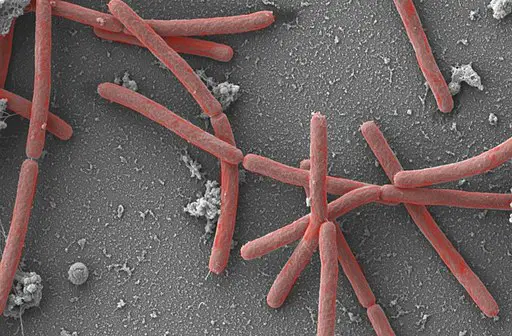Methanobacteria
Definition, Characteristics, Examples
Definition
Methanobacteria is a class of the phylum Euryarchaeota within the domain Archaea. Like some of the other members in the phylum, they are methanogens and thus produce methane as a byproduct of metabolism.
Species within the class Methanobacteria are divided into genera that include:
Members of the family Methanobacteriaceae
- Methanobacterium
- Methanobrevibacter
- Methanosphaera
- Methanothermobacter
A single genus in the family Methanothermaceae:
Methanothermus
Methanobacteria Characteristics and Examples
Methanobacterium
The genus Methanobacterium falls under the family Methanobacteriaceae within the class Methanobacteria. Members of the group are rod-shaped (curved, crooked, or straight), ranging between 0.5-1.0 um in width.
The majority of species are Gram-positive and non-motile; growing anaerobically at temperatures between 37 and 45 degrees C.
Though they are non-motile, some members of the group (e.g. Methanobacterium paludis) have fimbriae that allows them to bind to certain receptors and colonize given body regions of the host.
Some examples of Methanobacterium species include:
- Methanobacterium espanolae
- Methanobacterium formicicum
- Methanobacterium movilense
- Methanobacterium beijingense
- Methanobacterium congolense
- Methanobacterium thermoautotrophicum
Currently, over 50 species of the genus Methanobacterium have been identified. They can be found in terrestrial and marine environments as well as the digestive tract of some animals (e.g. Methanobacterium formicicum found in the gut of ruminants).
Though they can be found in different habitats, they have all been shown to be capable of growing by reducing carbon dioxide (to methane) using hydrogen as the donor.
Some of the strains are capable of using a variety of materials including secondary alcohols, formate, sulfide, and dinitrogen. In cases where they live in the gut of other animals, Methanobacteria form a symbiotic relationship where they protect the animal from various pathogenic microorganisms.
In turn, they benefit from conducive conditions that promote growth as well as access to nutrients.
Methanobrevibacter
Methanobrevibacter is also a genus of Archaea under the Class Methanobacteria. Depending on the species, Methanobrevibacter can be short rods, cocci, or oval in shape; ranging from 0.5 to 0.7 um in width (and 0.8 to 1.4 um in length).
Instead of peptidoglycan found in bacteria, the cell wall of these organisms consists of a substance known as pseudomurein.
Some examples of species within this group include:
- Methanobrevibacter smithii
- Methanobrevibacter curvatus
- Methanobrevibacter woesei
- Methanobrevibacter arboriphilicus
Like some of the other methanogens, Methanobrevibacter are strict anaerobes and thus grow well in the absence of oxygen. They prefer the temperature range between 37 and 39°C but can grow at a minimum of 30°C and a maximum of 45°C.
They have been isolated from a number of animals (within the gut) including humans and sheep (Methanobrevibacter smithii), rats, and geese (Methanobrevibacter woesei), and termite (Methanobrevibacter curvatus and Methanobrevibacter filiformis) among others.
In healthy animals, these organisms contribute to digestion and have been associated with weight gain in some animals (rats). In human beings, they help in the digestion of polysaccharides by breaking down some end products of other gut bacteria.
* In a study involving mice, the bacterium Methanobrevibacter smithii was shown to promote the degradation of fructons to acetate by Bacteroides thetaiotaomicron thus promoting energy production and weight gain.
Methanosphaera
Members of the genus Methanosphaera are also found in the gut of various animals. Unlike some of the other methanogens, they have been shown to prefer low hydrogen/methane-producing hosts (ruminants). That said, they are suspected of being more versatile than initially thought.
In Grey Kangaroo, for instance, they have been shown to use hydrogen and ethanol for methanogenesis and development. Though they play an important role in digestion in various animal hosts, they have been associated with several health issues in human beings.
In particular, they are thought to contribute to some digestive diseases and inducing proinflammatory responses. Some of the most popular species in this group are Methanosphaera stadtmanae and Methanosphaera cunculii.
Like some of the other methanogens, Methanosphaera are Gram-positive and non-motile. They may be spherical (cocci) or oval in shape with a G+C content of about 28%.
Methanothermobacter
The genus Methanothermobacter consists of rod-shaped methanogens that use hydrogen and carbon dioxide for growth reducing carbon dioxide acetate and methane. They also prefer relatively higher temperature ranges; between 60 and 65°C (thermophilic).
Some of the species within this group include:
- Methanothermobacter thermautotrophicus
- Methanothermobacter crinale
- Methanothermobacter wolfeii
* In culture, the species Methanothermobacter thermautotrophicus have a filamentous morphology.
Some of the other characteristics of these species include:
- Cell walls consists of pseudomurein (similar to peptidoglycan in structure and function)
- Gram positive (retain primary stain)
- Found in areas with relatively high temperature (e.g. natural gas fields in Japan and sewage sludge)
- Prefer areas with a pH value of about 7
Methanothermus
Methanothermus is the only genus within the family Methanothermaceae. It consists of Gram-positive, rod-shaped members that measure between 0.3 -0.4 um in width and 1 to 3 um in length.
Depending on the conditions, they may occur singly or form short chains. However, they can also form clusters that can grow to about 3mm in diameter.
As the name suggests, members of this group prefer relatively high temperatures. Ideally, they prefer temperatures of about 88°C. However, they can survive in temperatures of between 55 and 97°C.
* The cell envelope of these species is a double layer that consists of the inner pseudomurein and outer S layer.
Currently, there are two known species in the genus Methanothermus.
These include:
- Methanothermus fervidus
- Methanothermus sociabilis
Methanothermus fervidus is an extremely thermophilic species commonly found in very hot environments (e.g. water bodies that are almost boiling of the Icelandic hot spring).
In these habitats, the S-layer (paracrystalline protein surface layer) protects them against high temperature and other stresses like high salt levels. Compared to other methanogens, the S-layer of Methanothermus fervidus has been shown to contain higher levels of asparagine than aspartate.
* The G+C content in Methanothermus fervidus is about 33 mol percept of the total DNA and each layer of the complex cell wall is about 12 nm thick.
Methanothermus sociabilis is also a thermophilic species that can grow in an environment with temperature range between 55 and 97°C. Like Methanothermus fervidus, this organism also has a complex cell wall composed of pseudomurein and the S-layer.
Using fluorescence staining, researchers were able to identify fimbriae/pili on their surface.
Bacteriology as a field of study
Bacterial Transformation, Conjugation
How do Bacteria cause Disease?
Bacteria - Size, Shape and Arrangement - Eubacteria
Return from Methanobacteria to MicroscopeMaster home
References
Adam S. Bonin and David R. Boone. (2017). The Order Methanobacteriales.
Corinna Bang et al. (2014). The Intestinal Archaea Methanosphaera stadtmanae and Methanobrevibacter smithii Activate Human Dendritic Cells.
David R. Boone. (2015). Methanobacterium.
Lisa-Maria Mauerhofer et al. (2021). Hyperthermophilic methanogenic archaea act as high-pressure CH4 cell factories
Links
https://www.sciencedirect.com/topics/immunology-and-microbiology/methanobrevibacter-smithii
https://link.springer.com/referenceworkentry/10.1007%2F978-3-642-38954-2_411
Find out how to advertise on MicroscopeMaster!






